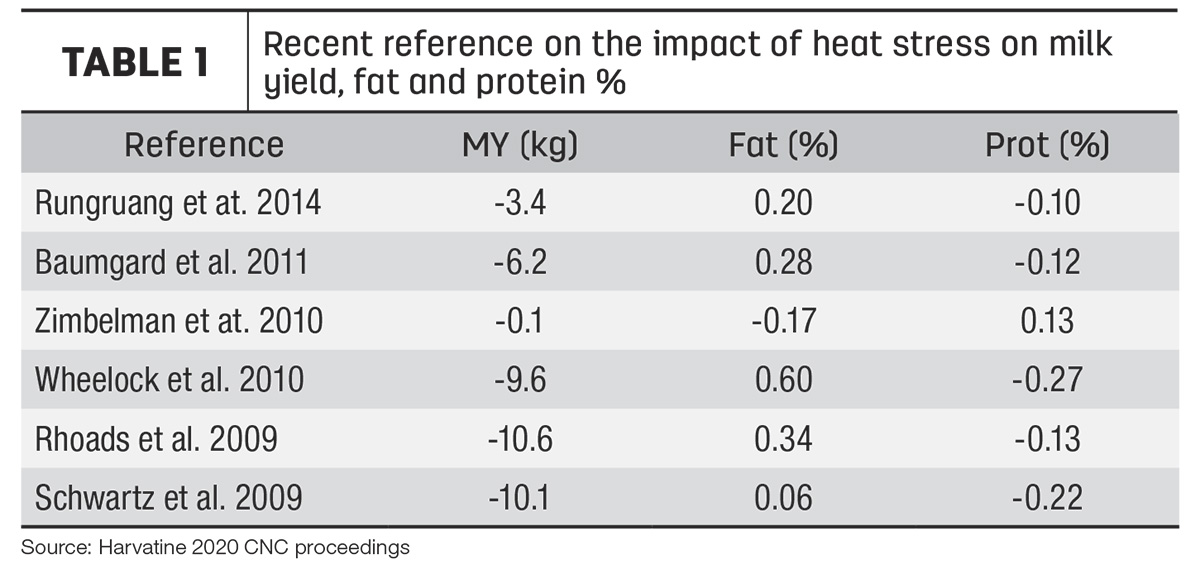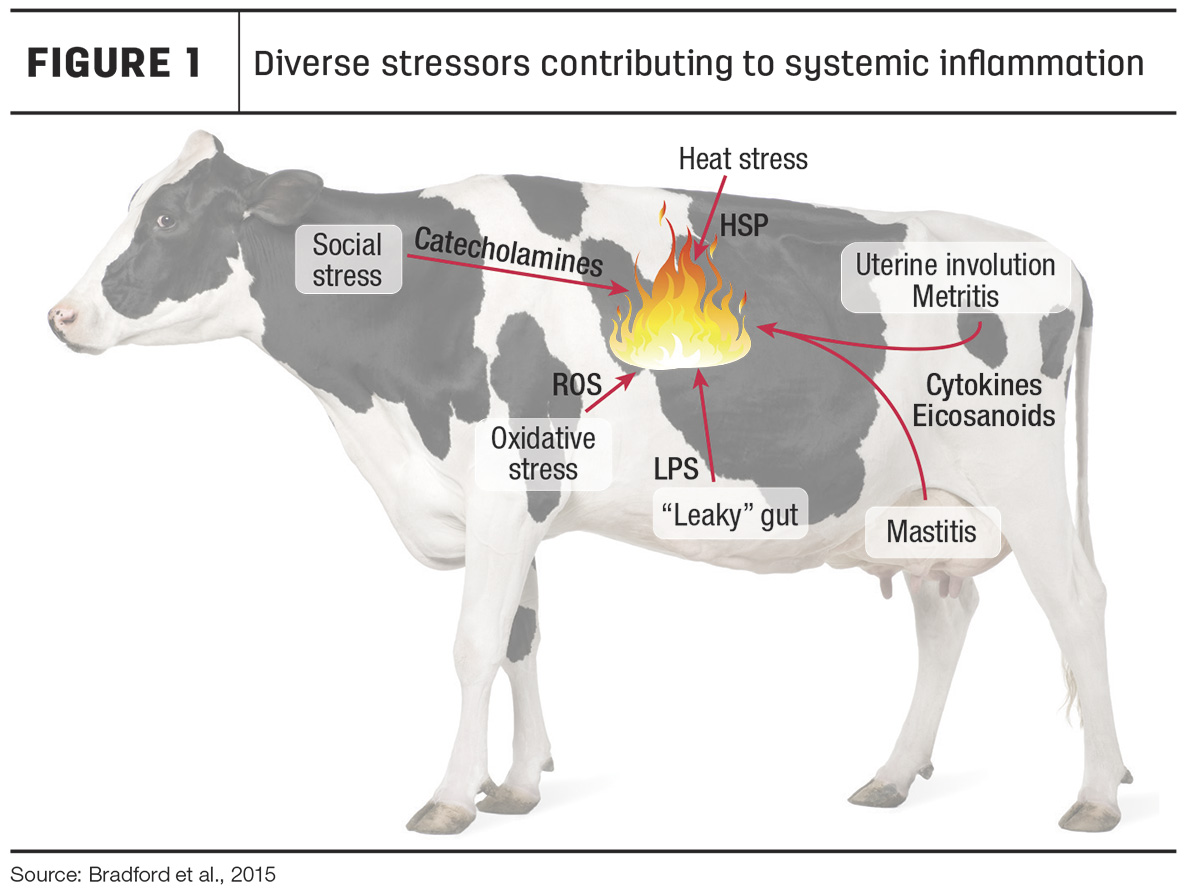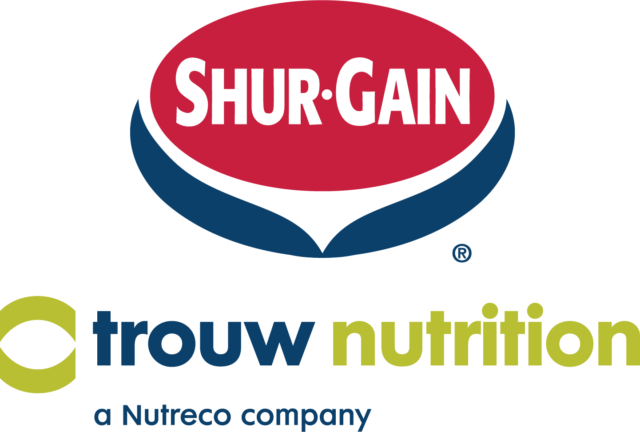To read this article in French, click here.
Cows that experience heat stress during the summer typically show recurrent effects during the following fall and winter months. This most negatively affects reproduction, but also influences production performance, which has an important economic impact on dairy producers.
We can quantitatively measure heat stress using the Temperature-Humidity Index (THI). When THI is higher than 68, cows will start to feel heat stress. In addition, we often forget that cows can begin experiencing heat stress at low temperatures – for example, a THI of 68 can be as low as 23ºC at 35% humidity.
The climate in Canada will tend to create moderate to moderate-severe conditions for our dairy cows during the hot and humid summer months. In recent years, these temperatures have been reached as early as April and May.
Heat stress can be defined as the condition the animal experiences when they are unable to dissipate the excess heat from their environment. The numbers of days with THI exceeding the comfort threshold for dairy cows has increased in the past decade. This phenomenon, coupled with the increase of dairy cow production, can pose a challenge to profitability for many dairy producers.
To overcome this challenge, many physiological, metabolic and behavioural changes are made to reduce heat stress. However, some of these adaptations may ultimately adversely affect long-term health, reproduction and/or productivity.
Typical responses to heat stress have been well documented and can include a decrease in dry matter intake (DMI), increase in water consumption, increase in metabolic requirements, increase in body temperature, negative impact on reproduction performances, decrease in rumen health and decrease in absorption and nutrient efficiency. Those examples are part of the short-term heat acclimation (STHA) response.
Long-term heat acclimation (LTHA) response is characterized by endocrine changes, prospectively with the goal of decreasing metabolic heat production and increasing heat dissipation. Generally, a decrease in milk yield and milk protein percentage are observed during hyperthermia, as we can see in Table 1.

Inflammation responses
Diverse stressors may contribute to systemic inflammation shown in Figure 1. One important physiological change identified in response to heat stress is an increase in inflammation responses.

Although we know that damage of intestinal barriers is not unique to heat stress, infiltration of immune cells, specifically macrophages, into the gut seems to be a key marker of heat stress. Macrophages are effector cells of the innate immune system that engulf bacteria and secrete both pro-inflammatory and antimicrobial mediators. Research in swine guts has shown that intestinal integrity and function can be compromised by the elevation of core body temperature due to heat stress. The ‘’leaky’’ gut phenomenon described above leads to a decreased barrier function due to reduced nutrient intake, feed restrictions, change in digesta flow rate or acidosis.
Although this mechanism might still play an important role in inflammation responses, recent studies have attributed the damage to the intestinal barrier to the infiltration of macrophage-like cells into the gut. The gut barrier integrity seems to be affected, and this could be caused by immune cells infiltrating the epithelium. The link to inflammation is that the penetration of toxic and bacterial compounds, due to the permeability of the intestinal barrier, cause the inflammation response by the macrophage-like cell during heat stress. This triggers a modulated immune response and induces an antioxidative defense mechanism to maintain homeostasis of the system. Thus, inflammation responses can damage the epithelial barrier during heat stress period. Modulation of immune responses during heat stress could help reduce negative impacts of internal heat stress.
Oxidative stress
Heat stress is known to affect the animal's oxidative status: It generally increases the production of free radicals, leading to oxidative stress. This oxidative stress, known as an imbalance between free radicals and antioxidants, can be observed in all stages of production, including dry cows. Research has shown that markers of oxidative status in the plasma of transition dairy cows experiencing heat stress were upregulated. In dairy cows, oxidative stress has a negative impact on immune and reproductive functions: increased mastitis frequency and higher somatic cell counts (SCC) in milk, decreased fertility, increased embryo mortality, postpartum retained placenta and early calving.
It is important to ensure optimal antioxidant supply to dairy cows to help them overcome the imbalance with the level of free radicals and limit some of those long-term heat acclimations. Much research has shown that supplementing additives that increase antioxidant capacity improves animal performance under heat stress conditions. Many commercial antioxidants or products high in vitamin E have shown to improve antioxidant capacity in dairy cows. Research also concluded that utilization of those types of products led to an increase in milk yield for dairy cows exposed to heat stress.
In a recent study, chromium yeast (which is used to improve antioxidant capacity) has shown to increase activity of antioxidant markers in dairy cows under hyperthermia. These are only some examples of antioxidant sources, but there are many different sources, coming from yeast base products, phytogenic or others that have demonstrated improved antioxidant capacity in dairy cow nutrition and reduced the negative impact of heat stress.
Heat shock protein
Increased heat dissipation, reduced feed intake and milk yield, and increased water intake are examples of the short-term heat acclimation responses mentioned above. But when the initial acclimation phase is complete and the cow gets “used” to the heat, long-term heat acclimation occurs.
These adaptations are caused by a reprogrammed gene expression and cellular response resulting in enhanced efficiency of signaling pathways and metabolic processes – and this, in large part, may be caused by the heat shock protein responses.
Heat shock proteins are specific proteins that are made when cells are briefly exposed to temperatures above their normal growth temperature. This change in the proteins’ three-dimensional conformation (protein aggregation) can greatly impact dairy cow performance.
Experiments have shown that heat stress can induce protein aggregation, which means that proteins can lose their function. However, not all protein seems to lose their conformation, and specific classes of proteins are more susceptible to heat-induced aggregation.
In dairy cows, it is typical to see milk protein content and yield dropping during heat stress, probably because of the aggregation response. Understanding what makes some protein less susceptible to heat stress could be a key discovery to reduce protein loss during summer months.
Understanding and modulating these physiological changes and the impact on the homeostasis response by the cows could help improve heat stress abatement strategies in dairy cows. There are many ways to help minimize systemic inflammation in the cow at a relatively low cost.
Nutritional changes starting with a properly balanced ration to meet cows’ energy demand, including specific additives to improve hydration, antioxidant levels and stimulating the cows’ immune system are the most economical and efficient strategies to support high-producing dairy cows during heat stress challenges.
As temperatures continue to rise, it is important to find new and innovative ways to improve dairy cow performance in a stressful environment, to maintain their productivity and, more importantly, their health.










